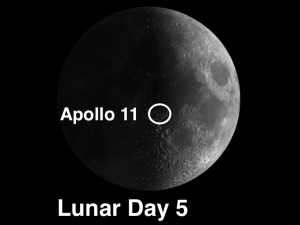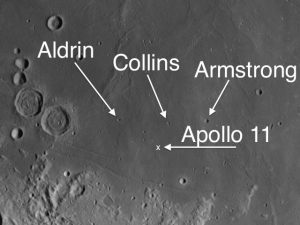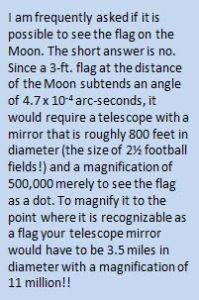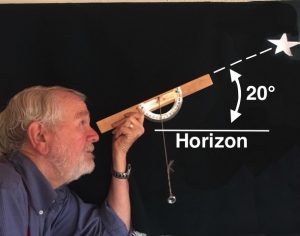 The week of Jan. 2–8 takes us from Lunar Day 4 through Day 10, a period when you can see the Moon at its best!
The week of Jan. 2–8 takes us from Lunar Day 4 through Day 10, a period when you can see the Moon at its best!
 This week we will highlight the Apollo 11 landing site on Tuesday evening.
This week we will highlight the Apollo 11 landing site on Tuesday evening.
Apollo 11: [NE/J12] The best time to see the Apollo 11 landing site is around Day 5, or 4-5 days after full Moon. You will find the landing site just east of the crater Sabine. In the close-by neighborhood are three tiny craters named for the astronauts of Apollo 11: Aldrin, Collins, and Armstrong. These craters can be used to test your telescope optics and the seeing conditions. From west to east, the crater diameters are: Aldrin (2.1 miles), Collins (1.5 miles) and Armstrong (2.9 miles).
OF ADDITIONAL INTEREST: MARS, THE MOON AND VENUS:

 On Monday evening, Mars, the Moon, and Venus will be lined up just over the SW horizon. The Moon will be just 3° from Mars and 8° from Venus, which will be a very bright -4.4 Mag (this should be bright enough to see in daylight if you know exactly where to look). To locate Venus in the daytime, use a home-made quadrant (for measuring altitude) and a compass. To make such a quadrant, attach a protractor to a rectangular stick (like a wooden ruler). Put a screw through the zero point of the protractor, tie a string to the screw and attach a weight to the string. Find out the current azimuth and altitude of Venus by using an app like Sky Safari. Using your quadrant and a compass, scan the approximate area with your binoculars. With practice you’ll be able to point exactly to the object in question.
On Monday evening, Mars, the Moon, and Venus will be lined up just over the SW horizon. The Moon will be just 3° from Mars and 8° from Venus, which will be a very bright -4.4 Mag (this should be bright enough to see in daylight if you know exactly where to look). To locate Venus in the daytime, use a home-made quadrant (for measuring altitude) and a compass. To make such a quadrant, attach a protractor to a rectangular stick (like a wooden ruler). Put a screw through the zero point of the protractor, tie a string to the screw and attach a weight to the string. Find out the current azimuth and altitude of Venus by using an app like Sky Safari. Using your quadrant and a compass, scan the approximate area with your binoculars. With practice you’ll be able to point exactly to the object in question.
======================
It is highly recommended that you get a copy of Sky and Telescope’s Field Map of the Moon, the very finest Moon map available for use at the telescope. It is available for $10.95 at www.skyandtelescope.com and on Amazon. All features mentioned in this blog will be keyed to the grid on the Field Map and will look like this: Plato: [NW/D9]
Credits:
Courtesy of Gray Photography of Corpus Christi, Texas
Lunar photos: NASA / USGS / BMDO / LROC / ASU / DLR / LOLA / Moon Globe. Used by permission
- Rupes Cauchy: A Best Known Fault on the Moon - July 22, 2024
- Moon Crater Schickard – Crater Floor has Stripes - July 15, 2024
- Moon Craters Langrenus and Vandelinus - July 8, 2024
Hi Andrew, nice blog. Don’t you mean 4-5 days after New Moon?